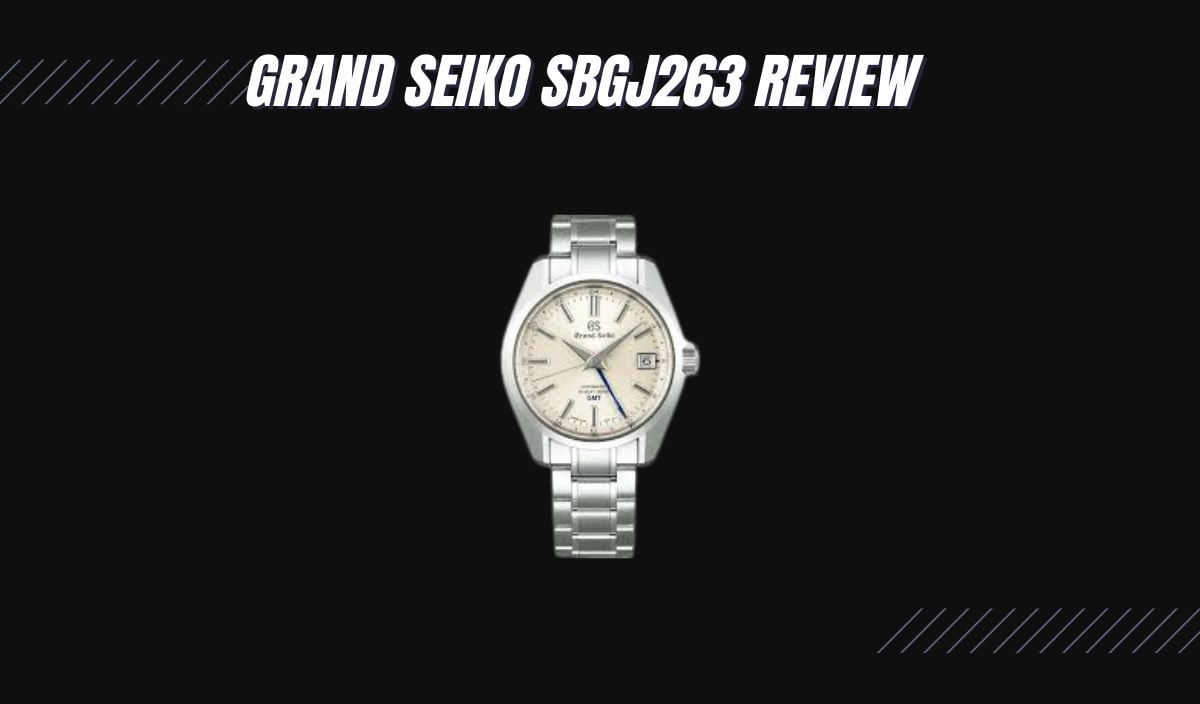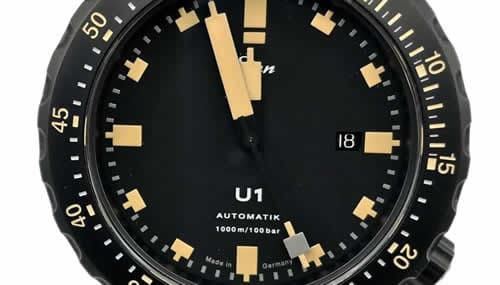
There’s a unique tranquility in being immersed in nature, surrounded by untouched landscapes brimming with life and beauty beyond human artistry. Occasionally, however, this natural splendor isn’t merely replicated but artfully represented—whether on a canvas or, in this case, on the dial of a watch.
Grand Seiko’s designers have mastered the art of crafting some of the most stunningly detailed dials in the watch industry.
Drawing inspiration from Japan’s natural beauty and rich cultural heritage, they capture the essence of lush forests, snowy mountains, serene rivers, and the changing seasons. These timeless dials reflect the breathtaking landscapes they witness throughout the year.
Our spotlight today is on the elegant Grand Seiko SBGJ263, a stunning homage to Mt. Iwate, the iconic mountain visible from the Grand Seiko studio in Shizukuishi.
This GMT traveler’s watch exudes unique style and functionality, crafted from Ever-Brilliant steel for exceptional durability. Much like the mountain it honors, photographs cannot capture its full beauty—the SBGJ263 is a masterpiece best appreciated in person.
History

Grand Seiko has introduced numerous models featuring a variety of dial colors, but the “Mt. Iwate” pattern has captivated enthusiasts since its debut in 2006. With its intricate design and diverse colorways, this dial has built a devoted following.
From the original white version to limited green editions exclusive to the Asian market, the Mt. Iwate dial has cemented itself as a cornerstone of the Grand Seiko collection.
The SBGJ263, introduced in 2023, succeeded the SBGH001 in 2019 as part of a broader Heritage Collection revamp. This model offers a modern interpretation of the iconic 44GS design, replacing four earlier models to refine and elevate the lineup.
The 44GS case itself holds a significant place in Grand Seiko’s history, serving as a direct homage to one of the brand’s earliest and most celebrated case designs.
While the dial and case embody Grand Seiko’s philosophy and timeless elegance, the SBGJ263 “Mt. Iwate” exemplifies the brand’s ability to honor its heritage while evolving to create the ideal modern wristwatch.
Case
As I previously mentioned, the SBGJ263 features the iconic 44GS case, a cornerstone of Grand Seiko’s design philosophy. Introduced in 1967, this case was crafted to reflect Japanese culture through its sharp edges, curved profile, and meticulous craftsmanship.
With a screw-down crown and a flawlessly polished finish, Grand Seiko aimed to create more than just a watch—they sought to establish a philosophy where every timepiece would “sparkle with quality.”
The SBGJ263 boasts a 40mm case diameter, a 42.5mm lug-to-lug distance, and a 19mm lug width. Its 14mm thickness, attributed mainly to the dual-curved sapphire crystal protecting the dial, adds to its robust construction. Despite this thickness, the 44GS case design ensures a comfortable fit on the wrist, striking a balance between presence and wearability.
While the SBGJ263 shares its size and many other features with its predecessor, what sets it apart is the use of Grand Seiko’s Ever-Brilliant steel. This exceptional alloy is significantly more resistant to corrosion than regular stainless steel and boasts a stunning finish.
Unlike anything seen in most other brands—even within Grand Seiko’s lineup—Ever-Brilliant steel exhibits a distinctive white hue. This unique tone is further enhanced by the famous Zaratsu polishing, giving the watch an unparalleled shine and presence.
The combination of the vintage-inspired 44GS case design and Ever-Brilliant steel makes the SBGJ263 one of the most captivating recent releases from Grand Seiko, in my opinion.
With its see-through case back and 100 meters of water resistance, this timepiece is an excellent addition to any wardrobe. Whether dressed up or casual, this stunner offers remarkable versatility and timeless appeal.
Dial
A beautiful case is elevated in status and elegance when complemented by an equally stunning dial. Grand Seiko has built a reputation for creating delicately textured dials that pay homage to Japanese nature and culture, and the SBGJ263 “Mt. Iwate” is no different.
The Grand Seiko Studio in Shizukuishi is surrounded by natural wonders that define Japan’s renowned beauty. The artisans at Grand Seiko pay homage to their homeland by reflecting its breathtaking landscapes in their meticulously crafted dials.
With the SBGJ263, they chose to reimagine their iconic Mt. Iwate dial, a tribute to the majestic volcanic mountain that overlooks the Shizukuishi studio.
The SBGJ263 “Mt. Iwate” features a stunning white sunburst dial adorned with intricate textured lines radiating toward the center, reminiscent of the ridges of its namesake mountain.
White dials are always captivating under shifting light, but this Mt. Iwate design takes it a step further. As the angle changes, the dial adopts a silvery tone, adding a dynamic and eye-catching dimension to its appearance.
As a GMT, the SBGJ263 offers the ability to track a second time zone—an essential feature for frequent travelers. What sets this timepiece apart is its unique approach to presenting the 24-hour markers.
Instead of placing them on an external bezel or painting them directly onto the dial, the inner rehaut serves as the second time zone tracker. With even numbers and markers for the odd hours, this design avoids cluttering the dial, adding a layer of sophistication and seamlessly integrating functionality into the watch’s aesthetic.
The sleek silver hour markers seamlessly complement the polished finish of the dauphine hands, creating a cohesive and refined design.
The white dial, paired with polished baton indices, exudes an elegant brilliance that brings the watch to life, balancing timeless sophistication with contemporary charm. Adding a touch of vibrancy, the stunning blue GMT hand introduces just the right pop of color to complete the dial’s captivating aesthetic.
A date window, framed in silver, is positioned at the 3 o’clock marker, blending seamlessly with the dial’s design. The Grand Seiko logo, rendered in silver, sits prominently under the 12 o’clock position, accompanied by the brand name in black.
Just above the 6 o’clock marker, the watch’s specifications are subtly displayed, noting that the SBGJ263 is an automatic GMT powered by the Hi-Beat movement. Adding a detail, the “GMT” lettering mirrors the blue hue of the GMT hand, enhancing the dial’s overall cohesive aesthetic.
Movement
Powering this timepiece is the Grand Seiko in-house Caliber 9S86, a movement that exemplifies the brand’s commitment to pushing the boundaries of mechanical watchmaking. Featuring the Hi-Beat 36000 vibrations per hour and a GMT time correction function, it delivers both precision and functionality, making the SBGJ263 a testament to Grand Seiko’s technical mastery.
The Hi-Beat 36000 is a remarkable technological breakthrough, representing decades of dedication and innovation. It took Grand Seiko nearly forty years to develop, test, and perfect this movement, solidifying its place as a pinnacle of horological achievement.
The original Hi-Beat 36000, the Caliber 9S85, was recognized for its accurate precision and lack of staggered movements when rolling around the dial.
While most standard mechanical watches operate at an average of 25,000 vibrations per hour, the 9S85 movement was engineered to perform at an impressive 36,000 oscillations per hour, giving rise to its “Hi-Beat 36000” moniker. This advanced mechanism provides exceptional accuracy, rated at +5 to -3 seconds per day, and boasts a robust power reserve of 55 hours.
The standout upgrade in the Caliber 9S86 is its integrated GMT function, allowing you to track a second time zone with ease—a perfect feature for frequent travelers.
By pulling the crown out one notch, you can adjust the hour hand independently without stopping the seconds hand, ensuring the Hi-Beat mechanism continues uninterrupted. This design not only preserves the movement’s precision but also adds convenience and efficiency for on-the-go adjustments.
Straps
The SBGJ263 is paired with a stunning Ever-Brilliant steel bracelet, showcasing the classic three-link design polished to perfection with Zaratsu finishing. For a tailored fit, the bracelet includes screwed half-links, though it lacks a micro-adjustment feature.
Securing the bracelet is a sleek three-fold clasp, elegantly engraved with the GS logo, adding a touch of refinement to this already exceptional timepiece.
With its 19mm lug width, the SBGJ263 may not offer an extensive range of options for swapping out bracelets, but it shines on the right strap.
If you find a suitable replacement, leather straps are an excellent choice. Whether you opt for classic black or a lighter shade of brown, the SBGJ263 stands out equally on leather as it does on its metal bracelet, offering versatility and elegance in every setting.
On-Wrist Experience
Whenever I get the opportunity to test a Grand Seiko, it inevitably becomes the centerpiece of my life during that time. It’s never just a watch—each model carries its own story and unique character. The SBGJ263 is no exception.
Though I’ve worn 44GS-style cases before, with their snug fit thanks to sharp angles and curved edges, this model felt refreshingly new. Stepping outside into the sunlight, the Ever-Brilliant steel transforms the watch into a radiant masterpiece, gleaming in a way that sets it apart from anything I’ve worn before.
I had the pleasure of wearing the SBGJ263 daily at work and even to two weddings, and each time, this snow-white beauty became a conversation starter.
While experimenting with different straps, my appreciation for this timepiece only grew. Its versatility is undeniable, though its thickness does make pairing it with tighter cuffs a bit challenging.
That said, the SBGJ263 is both comfortable and stylish, making it ideal for daily wear. Its versatility ensures it pairs well with various occasions, from casual to formal. The inner rehaut, serving as the GMT indicator, is a standout feature of this timepiece.
Unlike most GMT watches with a rotating bezel, this minimalist design approach offers a refreshing take. While I do appreciate a classic rotating bezel, I found myself thoroughly enjoying the clean and sophisticated aesthetic the rehaut provides.
Price & Availability
The Grand Seiko SBGJ263 “Mt. Iwate” is available at a retail price of $7,500. Pre-owned options often range around $4,000, offering a more budget-friendly alternative. For those interested, this remarkable timepiece is currently available through Exquisite Timepieces.
Conclusion
If you’re in the market for a stunning GMT with a beautifully detailed dial, the SBGJ263 is an exceptional choice. This timepiece offers versatility, comfort, and durability thanks to its robust materials and reliable in-house movement.
Like every watch in Grand Seiko’s Heritage Collection, the SBGJ263 is a tribute to the brand’s rich history, showcasing its commitment to crafting timeless pieces that genuinely shine with quality.























